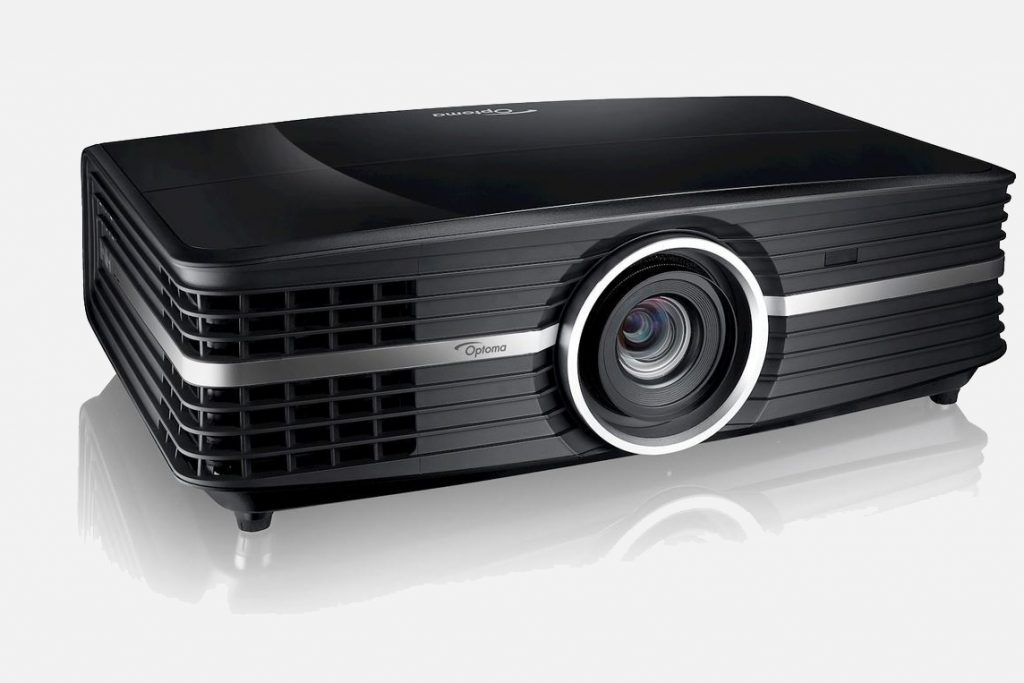
To have a truly immersive home theater experience, you need to have a big screen which engulfs you in the movie, transporting you in medias res alongside your favorite characters. Beyond television screens, which have become massive in their own right, projector screens can span entire walls, really bringing the action and drama into your cinema room and leaving you on the edge of your media room seats.
We talked about the basics of projector screens in one of our previous blog posts, but what about the projectors themselves? Those little light boxes are jam-packed with technological features designed to transform the way you view media. With so many features, it can be dizzying trying to find the right one for you and your needs—fret not, because we’re here to break it down and talk about one of our favorite cinema room accessories. From brightness, to lenses, and other features, we’ve got you covered.
The Main Types of Projectors
There are a few main types of projectors on the market today: LCD, LED, and DLP. LCD stands for liquid crystal display, LED stands for light-emitting diode, and DLP stands for digital light processing—all of these high-tech-sounding names refer to the innards of the projectors and how they work to provide you with a clear image.
LCD projectors work by utilizing polarized mirrors that reflect only certain colors of light. This means that each color is separated, and then later recombined. Each color then passes through an LCD panel which controls the intensity and saturation of each color. LCD projectors are mostly known for their vibrant color output and are typically one of the more affordable projector options on the market. These projectors are perfect if you’re either on a budget for your home theater, or if you’ve prioritized things like luxury cinema chairs and other lavish home theater furnishings and are looking for a great, baseline projector to get the job done.
LED projectors contain three colored bulbs—red, blue, and green—which combine to form a white light that passes through the lens to display an image on your screen. These projectors form a crisp, clear image with high-quality resolution and typically have extended lamp life. For those thinking about their budgets, LED projectors are a more mid-range option, with a great breadth of models that serve both basic and advanced needs.
DLP projectors use digital instruments which have many mirrors that possess the ability to create more than 16 million colors—who knew there were that many? This allows DLP projectors to create more natural and lifelike images. Their internal mirrors are much closer, which means the images are more fluid, lifelike, and consistent. DLP projectors usually have the most technology packed into them, capable of Bluetooth and carrying smart projector capabilities. Most DLP projectors on the market today carry the ability to produce the highly-coveted 4k output, really bringing the images on your screen to life with their sharp displays. But, with great image quality and technology comes a heftier price tag. DLP projectors are more expensive, but they do come with the best technology, sure to transform your home theater into something special.
Brightness
Another factor you need to consider when purchasing a projector is the brightness. In projectors, brightness is measured using lumens. The higher the lumen value, the brighter the image will be. Brightness is vital, because if the image is too dim in your home theater, you won’t be able to see what’s happening on-screen.
When shopping around for projectors, be on the lookout for both the white and color brightness lumen value, because they’re both important. The white lumen value refers to how bright and visible the image will be overall, while the color lumen value informs of how detailed and crisp the color output is on that projector.
If you’re one of the lucky ones with a basement media room where natural sunlight is all but non-existent, you won’t need to focus on brightness too much—a projector that has a brightness output of around 1500 lumens at minimum should do the trick where even someone in the back row of your cinema seating can still see a clear image on the screen.
If your home theater room is above ground in a room with windows—even if you’ve done your best to block out the natural sunlight—aim for a projector that delivers a brightness of at least 2500 lumens to still receive a crisp, perceptible image on the projector screen.
Lenses
One of the last things that you need to consider are the different types of lenses that projectors have. After all, this is one of the most integral parts, as lenses are responsible for casting the image onto your screen.
Before shopping for a projector lens, you’ll need to figure out your throw-to-width ratio, which is a measurement that helps you optimize your setup and get the closest-cut and best-quality image possible. Bust out your tape measure and get ready to take some notes! The “throw” part of the patio refers to the length of distance between where your projector is placed or mounted to where your projector’s screen lies. The “width” part of the ratio simply refers to the width of the projector screen you’re currently using—once you’ve got both measurements, divide your throw measurement by the width measurement, and you’ll have a working ratio to keep an eye out for while shopping.
Utilizing the throw-to-width ratio will give you a clear image that perfectly fits your projector screen—an important detail sure to put the finishing touches on your home theater room.
Ultimately, before buying a projector, consider all of these factors and which type of projector works for your own home theater—you’ll be well on your way to enjoying movies and shows on a massive screen sure to keep you on the edge of your seat.
